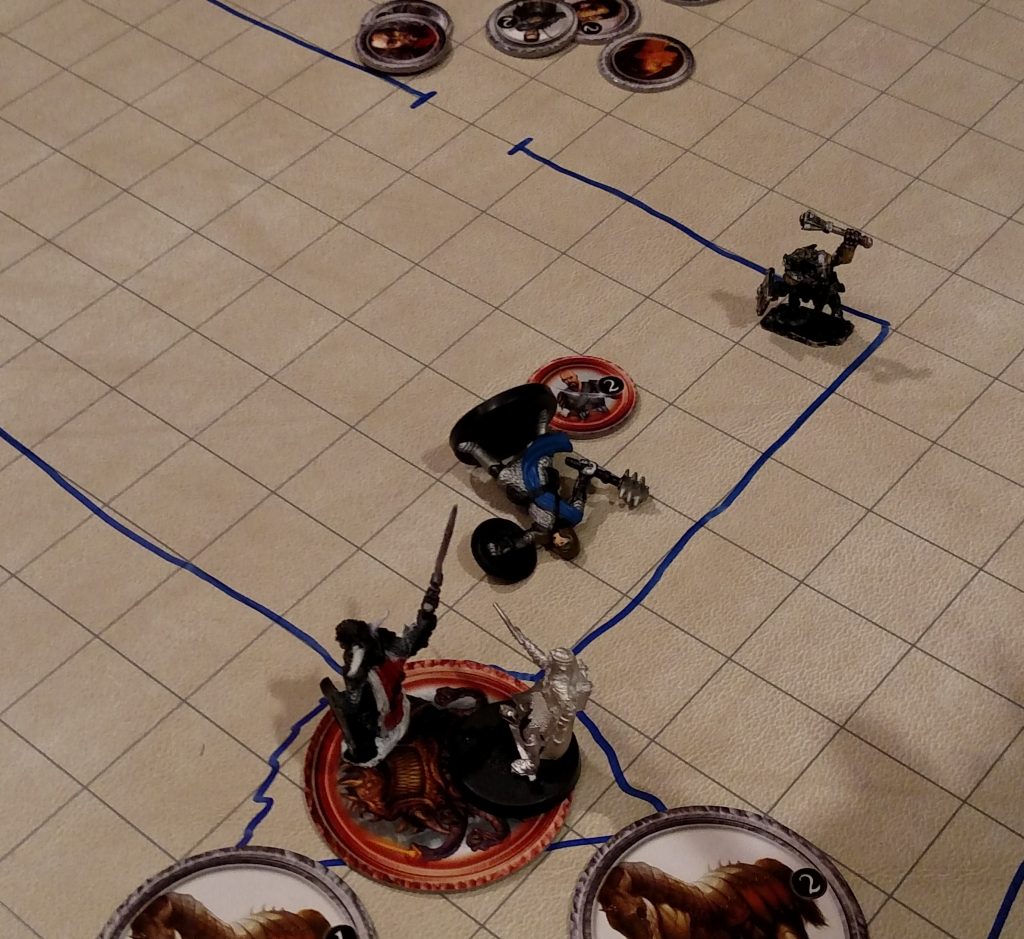It appears that I struck a real chord with Tuesday’s article on player character death. Why did so many GMs and players respond so passionately to my post? Because players sometimes get mad at GMs when their characters die.
Not all players and not always. But it does happen and it creates tension at the tabletop, when players are angry over their characters’ deaths.

Another final shot of our fallen comrade. RIP Elder Cunningham. FWIW, the beholder there is actually a giant snake. I wouldn’t do that to Level 2 adventurers!
One particular response (from @theTinyGM on Twitter) took exception to my use of the word “threat” in relation to PC death. Her concern was that the language of a threat might set up a confrontational relationship between GM and player. Of course, nothing could be further from my intention.
But it raises the question: can GMs create conflict and challenges for PCs–can they “threaten” the livelihood of adventurers–without creating a confrontational atmosphere? I’m convinced you can! If I can pull it off, you can too!
Here are the three steps you can take to create a challenging situation that will end in nothing but fun and mutual respect at your gaming table:
Own the fact that you (as GM) introduce threats
Now, again, when I use the word “threat,” I’m thinking purely in story-telling terms. In story terms a threat is something outside the control of the protagonist, which may cause danger.
Threats can be environmental. A storm, a natural (or unnatural) disaster, or even the darkness of night can threaten player characters. It puts them in a position that raises the possibility of danger.
Threats can be interpersonal. Animosity, outright opposition, and fighting can threaten PCs. Even division within the character group can be generated, putting them at loggerheads philosophically or emotionally, so that danger rises. Think of Frodo and Boromir!
Threats can be internal. If you can present PCs with situations that force them to choose between themselves and their team, between their own welfare and the welfare of others–these emotional strains are indeed an internal threat to the PC and the mission! Additionally, if you exploit the intentionally chosen flaws of PCs, so that they are pulled in a different direction, it raises the stakes for danger.
Death of a player character is the result of a threat. However, in some circumstances death is more present than others. If your PCs are aiding a village struggling with a lethal disease, there is a good chance that they may die. If your PCs are invading a dungeon, again, death is a possibility. It is not the threat, per se, but it is a very present consequence that comes from the threat.
Recognize that players take risks…usually intentionally
Why did Elder Cunningham, ever-blessed and never-intelligent Cleric of Mischa, die? Well, that’s a complicated question with several answers:
- Because the [unnamed dungeon for those who haven’t played the module] in T1: The Village of Hommlet was filled with lethal threats,
- Because these threats succeeded in their 50% chance of spotting the approaching adventurers,
- Because the scout who went to check out the unnamed dungeon failed his check for surprise and was overtaken by a giant snake,
- Because Cunningham’s party member cried out for help, attracting the attention of more threats with better attacks,
- Because Cunningham and his party went to their comrade’s aid,
- Because Cunningham rushed valiantly into battle,
- Because an enemy randomly (by roll of a d4) chose to attack Cunningham,
- Because that enemy randomly (by roll of a d20) rolled a hit,
- Because that enemy randomly (by roll of a d6) rolled enough damage to reduce Cunningham to 0 hit points, and
- Because Cunningham’s party members had no potions or healing spells.
Here’s my point. The GM creates threats, but players respond to threats. When players respond to threats, they are taking a risk. Risk is volitional.
That said, it’s not always intentional! Players may be “off their game.” They may not be fully engaged. But isn’t that how life goes sometimes? We don’t recognize the risk we’re taking until the consequence kicks in!
That said, risk is often (even usually) intentional. Players are not sheep wandering blindly toward the slaughter…that is, unless you are a very cunning Game Master. If you are of a cunning type, you may ask if your players are into that sort of thing. It’s easy to think you’re being cunning, when you’re actually being unclear and obfuscating. So a little feedback can be helpful.
Ideally, you want players choosing to undertake a risk. You want them to say, “Yes. I see your threat. And I will seek to overcome it!” Or “Yes. I see your threat. And screw that! I’m going back to the tavern!” Either is perfectly fine. It is possible for threats to be too great. Retreat is always an option.
A brief aside from Gary Gygax
One tip that I’ve learned from Gary Gygax: there’s safety for GMs in randomness.
When Elder Cunningham was targeted in our AD&D game, it wasn’t because I have a malicious feeling toward his character or player. It was because I rolled 3 on a 1d4, when I had designated him as PC #3 based upon position. There was no clear tank or leader, so the enemies had to choose whom to attack. I used a d4 to decide for them.
When PCs are facing off against unknown foes without previous grudges and relationships, I encourage you to adopt a method such as this. Not only does it mitigate contention at the table, but it leaves some surprise to you as the GM.
Spend time strengthening your threats
What’s the important takeaway for GMs? Your players may get upset if their characters die. They may even get upset by the threats thrown at them. But if you make it clear that you are neither targeting their characters, nor forcing them to undertake a threat, I think you will be freed to do your job well. In fact, that level of honesty and interaction between GM and player will lead to a very healthy environment at the game table.
So spend more time on your threats this week! Think through not only the external side of it (is it environmental, interpersonal, internal, etc.), but think about how it will impact your player characters. Will it compel them to action? Will it make them want to take a risk? Those are the threats that we want present to our players.
So know your players well. Know their characters well! And present threats that will make them want to take a risk. For that, my friends, is the beginning of an excellent gaming session.
Join the conversation about threats and risk over at the Mad Cleric Facebook page!

Unless my character death was petty or felt antagonistic, I’ve never been upset about my character’s demise. Actually, in the games I’ve played I can’t recall a character death that wasn’t reasonable… Also, having the distinct honor of being the first PC death in our AD&D game, I can attest that I wasn’t overly upset or felt personally attacked out of character- the dice are cruel and it doesn’t always go your way. It’s important to remember that we don’t play for the instances when the dice fail us, we play for those epic moments when the stars align and luck favors the bold. Even when the dice fail, a suitably courageous death is a character memory that sticks with you. We should play for the collective experience, not for an inevitable victory.
Couldn’t agree more. Our group is awesome, isn’t it? Love playing with you guys.
Interesting article MC. I’m guessing your potential opponents are reading this too.
Opponents really is not how I consider players. Some GMs might, but I consider RPGs a collaborative storytelling process, rather than a competitive match.
Well said.
Many thanks! And thanks for reading.